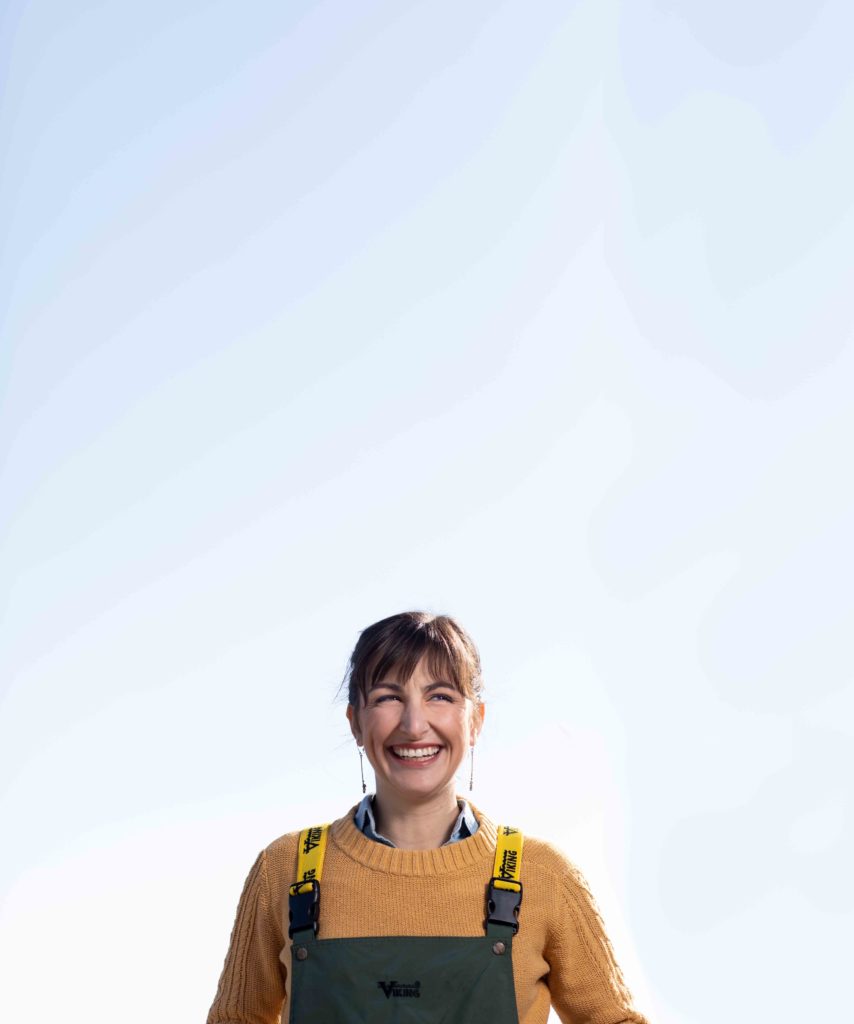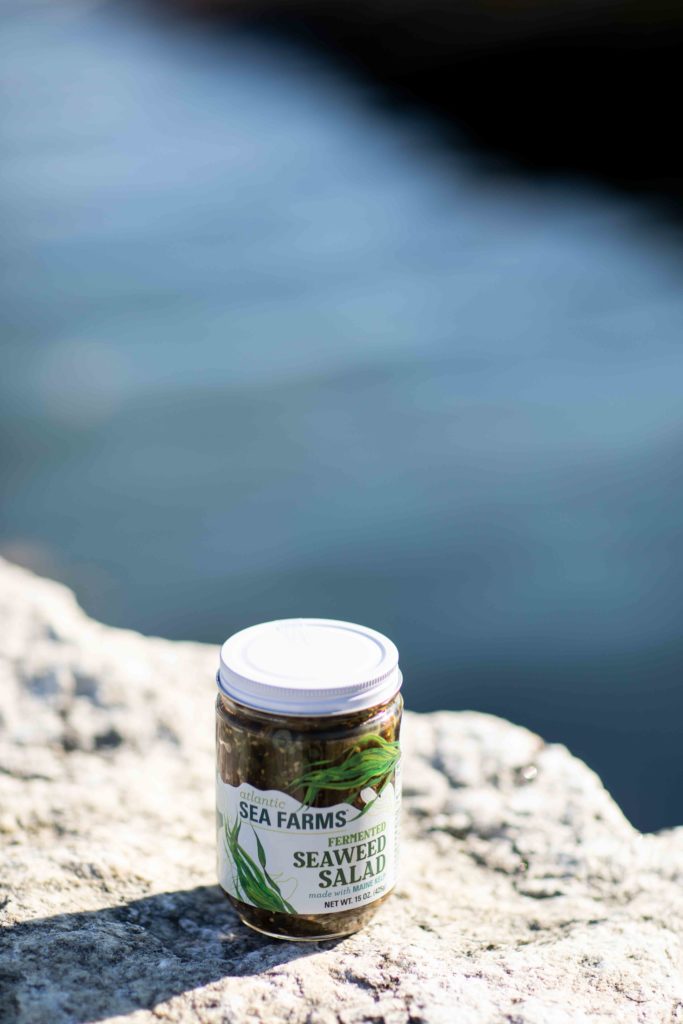Sea Change
With new retail products and a growing number of fishermen-farmers, Atlantic Sea Farms is getting more Maine kelp onto plates around the country.

Sea Change
With new retail products and a growing number of fishermen-farmers, Atlantic Sea Farms is getting more Maine kelp onto plates around the country.
Issue: January 2020
By: Susan Axelrod
Photography: Kari Herer
At Atlantic Sea Farms’ production facility in Saco, a small group of women in hairnets and gloves are packing freshly blanched ribbons of deep green kelp into plastic bags. President and CEO Briana Warner offers me a taste, and the pleasantly crunchy strands remind me not so much of the sea as, surprisingly, of green beans. Its versatile flavor is just one reason to embrace this nutrient-dense, sustainable Maine product. In just 18 months, Warner has transformed and rebranded Ocean Approved, which originated in 2009 as the first commercial seaweed farm in the United States, into a model of culinary innovation and forward-thinking economic development with the motto “Kelp the earth.” This year, Atlantic Sea Farms will work with 24 fishermen from Casco Bay to Eastport (up from 16 in 2019) and expects to harvest 600,000 pounds of fresh kelp. The kelp plants are started on kite string in filtered seawater at the Saco facility and given to the fishermen, who coil the string around rope and submerge it seven feet underwater. The mature kelp is harvested, cleaned, cut, blanched, and frozen. It is then offered in packages of ready-cut kelp and pureed kelp cubes for food service and retail. And last fall, the company rolled out its first jarred products: Fermented Seaweed Salad, which is made with blanched kelp, and Sea-Beet Kraut and Sea-Chi—a mild kimchi—both made from raw kelp fermented in barrels by a woman-owned small business in Rhode Island.
Q. Why should we eat kelp?
A. We call it the virtuous vegetable. It’s fresh, it’s American, it’s clean, it’s farmed by fishermen (not on big farms), it helps mitigate ocean acidification, it’s super healthy, and it tastes good. It’s got more calcium than milk—more calcium per ounce than any food on the planet. It’s super high in potassium and iodine, which is great for thyroid function, and potassium, magnesium, and vitamin B12. Our fermented seaweed products have a ton of probiotics, which is good for gut health, and our kelp cubes add a nutrient boost to smoothies. They’re an incredible way to eat greens and get these nutrients for people who would not eat a seaweed salad—like my two young kids.

Q. What makes kelp farming such a good thing for Maine?
A. I’m a development economist by trade, and I think the most fascinating way development economics can be applied is by helping to prevent a problem before it ever happens. As we know, the Gulf of Maine is warming faster than 99 percent of the world’s oceans, and the dominant fishery on the Maine coast is lobster. Right now, we’re in the middle of a lobster boom, which means if we’re looking for ways for fishermen to diversify their incomes in the face of impending climate change, they already have the boats, the equipment, and the capital. It’s a workforce of owner-operators who are super-qualified; they have a huge advantage over anyone else who wants to get into aqua-culture. Kelp is a lower-capital-barrier investment than other types of aquaculture, and kelp grows in the opposite season from lobster; it’s a winter crop, so it’s out of the water and profitable, if you grow it at scale, before you have to put your lobster traps in.
Another factor is that kelp not only helps people adapt to climate change, it also helps mitigate climate change. We have too much carbon in the air, which along with nitrogen from other sources is being absorbed by the ocean, making it more acidic. A shelled organism like a mussel or an oyster in a more acidic ocean is going to become increasingly more brittle. When you’re planting kelp, you’re creating an additional habitat, and when you pull it out, you remove carbon and nitrogen from the water. We did some research with the Bigelow Laboratory for Ocean Sciences, growing mussels alongside our kelp, and found that the shells were almost doubly as strong in one six-month growing period. The mussel meat was also substantially larger, which could be part of the ocean acidification piece, or that they were feeding off the nutrients from the kelp.
Q. What are some good ways to use the ready-cut kelp?
A. It’s been our biggest seller in food service because chefs like to make their own, better version of the seaweed salad you see in sushi bars [which is dried, reconstituted, and dyed seaweed grown in Asia in water with a high lead content]. We have a recipe for the salad right on the retail package. A lot of people put it on salads; it adds a really great crunch. At her restaurants, Linda Bean puts it in a signature slaw called Kelpi-slaw. If you want to get a little more creative, it’s fantastic in pasta sauces, especially clam sauce, and paella, but you can also put it in soups such as minestrone, because the flavor is fresh and vegetal.

Q. What was the reasoning behind the fermented kelp products?
A. We made a baseline assumption that people who are seeking to eat seaweed are likely more adventurous and health focused, and probably more conscious about where their food is grown. The probiotic craze is really catching on; it’s the fastest growing grocery segment, yet it’s basically just kimchi, sauerkraut, and kombucha. We thought if we could innovate in the seaweed space and innovate in the fermented space that consumer group would be substantial. But we also needed to preserve it and an easy way to eat it. Fermentation works really well with seaweed, and it boosts the nutrients. Our Sea-Chi and our seaweed kraut are both raw, which helps people who are on the raw diet, and with our seaweed salad, we can make a healthier, more delicious, natural version of the seaweed salad usually found at sushi bars. It’s really easy to use right out of the jar, it tastes great, and it’s preserved for a year.

